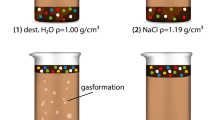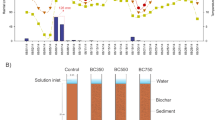Abstract
Among ex situ remediation technologies, stabilization/solidification (S/S) provides for the addition of a binder to dredged materials in order to chemically immobilise the contaminants and improve mechanical behaviour of sediments. The simplest form of treatment is obtained by the addition of Portland cement or lime (calcium oxide), although other additives such as adsorbents may be added. Nevertheless, the success of the S/S treatment may be affected by the contaminants present or by the salt content in the water. In this study, experimental laboratory investigation was carried out on sediments carefully collected from the Mar Piccolo of Taranto in Southern Italy, contaminated by heavy metals, polycyclic aromatic hydrocarbons (PAHs) and polychlorinated biphenyls (PCBs); the goal was to explore the effectiveness of S/S treatment by using Portland cement/lime as binders, monitoring over time (28 days) the leaching of the different mixtures of treated sediment. It is noted that the Mar Piccolo of Taranto is one of the sites of national interest subject to remediation by the Italian government. Once taken within the first meter under the sea floor by a team of experienced divers, the samples were stored at a controlled temperature, characterised in terms of grain size and physical-chemical characteristics and treated by S/S laboratory tests. The results indicate that the addition of binders increased the pH of the mixtures with a consequent leachability of different metals. The mobility of the metals appeared to be governed also by the curing time. The performance of the mixtures in terms of immobilised metals was influenced by the presence of organic contaminants (e.g. organic matter, PAHs and PCBs). As a lesson, high organic matter and fine-grained particles can negatively affect the effectiveness of the S/S treatment in terms of metal immobilisation.





Similar content being viewed by others
References
Apitz SE (2010) Waste or resource? Classifying and scoring dredged material management strategies in terms of the waste hierarchy. J Soils Sediments 10:1657–1668
Barjoveanu G, De Gisi S, Casale R, Todaro F, Notarnicola M, Teodosiu C (2018) A life cycle assessment study on the stabilization/solidification treatment processes for contaminated marine sediments. J Clean Prod 201:391–402
Cao X, Dermatas D, Xu X, Shen G (2008) Immobilization of lead in shooting range soils by means of cement, quicklime, and phosphate amendments. Environ Sci Pollut Res 15:120–127
Cappuyns V, Deweirt V, Rousseau S (2015) Dredged sediments as a resource for brick production: possibilities and barriers from a consumers’ perspective. Waste Manag 8:372–380
Colangelo F, Cioffi R, Montagnaro F, Santoro L (2012) Soluble salt removal from MSWI fly ash and its stabilization for safer disposal and recovery as road basement material. Waste Manag 32:1179–1185
Couvidat J, Benzaazoua M, Chatain V, Bouamrane A, Bouzahzah H (2016) Feasibility of the reuse of total and processed contaminated marine sediments as fine aggregates in cemented mortars. Constr Build Mater 112:892–902
Desogus P, Manca P, Orrù G, Zucca A (2012) Stabilization–solidification treatment of mine tailings using Portland cement, potassium dihydrogen phosphate and ferric chloride hexahydrate. Miner Eng 45:47–54
Drouiche MC, Moussaceb K, Joussein E, Bollinger JC (2019) Stabilization/solidification by hydraulic binders of metal elements from landfill leachate. Nova Biotechnol Chim 18:72–83
EMODnet (2017). The European Marine Observation and Data Network. http://www.emodnet.eu/ (accessed 26 September 2019)
EPA (1994). Method 200.7: Determination of metals and trace elements in water and wastes by inductively coupled plasma - atomic emission spectrometry. Environmental monitoring systems laboratory office of research and development U. S. Environmental Protection Agency, Cincinnati, OH
Ferraro A, Farina I, Race M, Colangelo F, Cioffi R, Fabbricino M (2019) Pre-treatments of MSWI fly-ashes: a comprehensive review to determine optimal conditions for their reuse and/or environmentally sustainable disposal. Rev Environ Sci Biotechnol 1-19
Hasegawa H, Rahman I, Rahman M (2016) Environmental remediation technologies for metal-contaminated soils. Springer, Tokyo
ICRAM (2004) Values of intervention for sediments of areas strongly anthropized with reference to the site of reclamation of national interest in Taranto (in Italian). Central Institute for Scientific and Technological Research applied to the Sea, Rome
Kogbara RB (2014) A review of the mechanical and leaching performance of stabilized/solidified contaminated soils. Environ Res 22:66–86
Kogbara RB, Al-Tabbaa A, Yi Y, Stegemann JA (2012) pH-dependent leaching behaviour and other performance properties of cement-treated mixed contaminated soil. J Environ Sci 24:1630–1638
Labianca C, De Gisi S, Notarnicola M (2018) Assessing the correlation between contamination sources and environmental quality of marine sediments using multivariate analysis. Environ Eng Manag J 17(10):2391–2399
Legislative Decree 152 (2006). Environmental regulations, (in Italian). Italian Official Journal, No. 88, 04/04/2006
Lofrano G, Libralato G, Minetto D, De Gisi S, Todaro F, Conte B, Calabrò D, Quatraro L, Notarnicola M (2016) In situ remediation of contaminated marine sediment: an overview. Environ Sci Pollut R 24(6):5189–5206
Messina F, Ferone C, Molino A, Roviello G, Colangelo F, Molino B, Cioffi R (2017) Synergistic recycling of calcined clayey sediments and water potabilization sludge as geopolymer precursors: upscaling from binders to precast paving cement-free bricks. Constr Build Mater 133:14–26
Ministerial Decree (1998). Identification of not-hazardous waste subjected to simplified recovery procedures (in Italian). Italian Official Journal No. 88, 16/04/1998
Pan Y, Rossabi J, Pan C, Xie X (2019) Stabilization/solidification characteristics of organic clay contaminated by lead when using cement. J Hazard Mater 362:132–139
Sollecito F, Vitone C, Miccoli D, Plötze M, Puzrin AM, Cotecchia F (2019) Marine sediments from a contaminated site: geotechnical properties and chemo-mechanical coupling processes. Geosci. 9(8):333
Silitonga E, Levacher D, Mezazigh S (2010) Utilization of fly ash for stabilization of marine dredged sediments. Eur J Environ Civ Eng 14:253–265
Stegemann JA, Zhou Q (2009) Screening tests for assessing treatability of inorganic industrial wastes by stabilisation/solidification with cement. J Hazard Mater 161:300–306
Todaro F, De Gisi S, Notarnicola M (2016) Contaminated marine sediments: waste or resource? An overview of treatment technologies. Procedia Environ Sci Eng Manag 3(3):157–164
Todaro F, De Gisi S, Notarnicola M (2018) Sustainable remediation technologies for contaminated marine sediments: preliminary results of an experimental investigation. Environ Eng Manag J 17(10):2465–2471
Todaro F, Vitone C, Notarnicola M (2019a) Stabilization and recycling of contaminated marine sediments. E3S Web Conf 92 11004
Todaro F, De Gisi S, Labianca C, Notarnicola M (2019b) Combined assessment of chemical and ecotoxicological data for the management of contaminated marine sediments. Environ Eng Manag J 18(10):2287–2296
Vitone C, Federico A, Puzrin AM, Ploetze M, Carrassi E, Todaro F (2016) On the geotechnical characterization of the polluted submarine sediments from Taranto. Environ Sci Pollut Res 23:535–553
Wang D, Abriak NE, Zentar R, Xu W (2012) Solidification/stabilization of dredged marine sediments for road construction. Environ Technol 33:95–101
Wang D, Abriak NE, Zentar R, Chen W (2013) Effect of lime treatment on geotechnical properties of Dunkirk sediments in France. Road Mater Pavement 14:485–503
Wang L, Kwok JSH, Tsang DCW, Poon C (2015) Mixture design and treatment methods for recycling contaminated sediment. J Hazard Mater 283:623–632
Acknowledgements
The experimental activities described were funded by the Special Commissioner of the Italian government for urgent measures of reclamation, environmental improvements and redevelopment of the Taranto area (South of Italy). The authors gratefully acknowledge UNICALCE S.p.A for providing the additives used for the research.
Author information
Authors and Affiliations
Corresponding author
Additional information
Responsible editor: Philippe Garrigues
Publisher’s note
Springer Nature remains neutral with regard to jurisdictional claims in published maps and institutional affiliations.
Rights and permissions
About this article
Cite this article
Todaro, F., De Gisi, S. & Notarnicola, M. Contaminated marine sediment stabilization/solidification treatment with cement/lime: leaching behaviour investigation. Environ Sci Pollut Res 27, 21407–21415 (2020). https://doi.org/10.1007/s11356-020-08562-1
Received:
Accepted:
Published:
Issue Date:
DOI: https://doi.org/10.1007/s11356-020-08562-1




